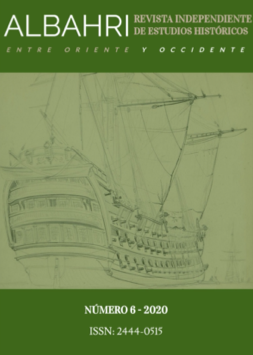Un deterioro incesante: las repercusiones del pasado en la actualidad libanesa
Palabras clave:
Líbano, historia, Oriente Medio, conflictos, guerra civilResumen
En las últimas décadas, Líbano ha experimentado un incesante deterioro político, económico y social como consecuencia de una lucha histórica contra las injerencias de las potencias internacionales y un sistema político sectario disfuncional que se resiste al cambio. Utilizando datos segundarios, este artículo pretende revisar la historia del Líbano, desde el dominio otomano, el protectorado francés y la guerra civil libanesa y su período posterior, para explicar cómo esa interrelación cronológica ha llevado la situación actual del Líbano, al borde del precipicio. Por tanto, Líbano sigue siendo una "zona colchón", víctima de un sistema confesional que no hace más que mantener a los rivales separados y a las dinastías políticas en su lugar.
Descargas
Citas
AL ARISS, A. (2010): “Religious diversity in Lebanon: lessons from a small country to the global world”, en F. Mustafa, J. Syed (eds.): Managing cultural diversity in Asia: A research companion, Edward Elgar Publishing, Cheltenham, pp. 56-72.
AL JAZEERA (2009): “A chronology of key events in Lebanese history”, Recuperado de: https://www.aljazeera.com/focus/lebanon2009/2009/06/200961145224882101.html
ALAMI, M. (28 de mayo de 2013): “Averting a Crisis: Syrian Refugees in Lebanon”, Recuperado de: https://carnegie-mec.org/2013/05/28/averting-crisis-syrian-refugees-in-lebanon-pub-51905
ANDERSEN, L. E. (2016): The neglected: Palestinian refugees in Lebanon and the Syrian refugee crisis, Danish Institute for International Studies, Copenhagen.
BAILLE, R., y CHALIER, J. (2018) : “Ersal, le conflit syrien au Liban”, Esprit, 4, pp. 97-101.
CHAY, J. (Ed.). (2019): Buffer states in world politics. Routledge, Londres.
CHERRI, Z., GONZÁLEZ, P. A., y DELGADO, R. C. (2016): “The Lebanese–Syrian crisis: impact of influx of Syrian refugees to an already weak state”, Risk management and healthcare policy, 9, pp. 165-172.
CRESWELL, J. W., y POTH, C. N. (2016): Qualitative inquiry and research design: Choosing among five approaches. Sage publications, Thousand Oaks.
DAVIE, M. F. (2005): “De l'utilité géopolitique des espaces libanais”, Outre-Terre, 4, pp. 355-372.
DAVIS, H. T. (1995): 40 Km Into Lebanon: Israel's 1982 Invasion. Diane Publishing, Darby.
DUPUY, E. (2006) : “Mutations géopolitiques et socio-économiques au Liban Une instabilité chronique?”, Recuperado de: http://www.academiedegeopolitiquedeparis.com/mutations-geopolitiques-et-socio-economiques-au-liban-une-instabilite-chronique/
EL HAJJ, S. (2020): “Writing (from) the Rubble: Reflections on the August 4, 2020 Explosion in Beirut, Lebanon”, Life Writing, 18(1), pp. 7-23.
EL RAJJI, R. (2014). The leaves of one tree: Religious minorities in Lebanon. London, England: Minority Rights Group International. Recuperado de: https://minorityrights.org/publications/the-leaves-of-one-tree-religious-minorities-in-lebanon-december-2014/
FAWAZ, L. T. (1994): An occasion for war: civil conflict in Lebanon and Damascus in 1860. University of California Press, Berkeley.
GHANDOUR, H. (2017): Naturalised Palestinians in Lebanon: experiences of belonging, identity and citizenship. Tesis doctoral defendida en la Swinburne University of Technology.
GREENSHIELDS, T. H. (1978): The settlement of Armenian refugees in Syria and Lebanon, 1915-1939. Tesis doctoral defendida en la Durham University.
HALLINAN, C. (2011): “How Lebanon Got So Complicated”, Recuperado de: https://fpif.org/how_lebanon_got_so_complicated/
HITTI, P. K. (1965): Short History of the Lebanon. Macmillan International Higher Education, London.
HOURANI, G. (2011): The 1994 Naturalisation Decree. Emigration Research Centre. Notre Dame University, Paris.
HUMUD, C. E. (2018): “Lebanon”, Current Politics and Economics of the Middle East, 9(2/3), pp. 313-365.
KOCH, C. (2005): “La Constitution libanaise de 1926 à Taëf, entre démocratie de concurrence et démocratie consensuelle”, Égypte/Monde arabe, 2, pp. 159-190.
KROPP, A. J. (2009): “The cults of Ituraean Heliopolis (Baalbek)”, Journal of Roman Archaeology, 22, pp. 365-380.
LUFT, G. (2000): “Israel's security zone in Lebanon-A tragedy?” Middle East Quarterly, 8(3), pp. 13-20.
MACARON, J. (2018): “Syrian Refugees in Jordan and Lebanon: The Politics of their Return”, Recuperado de: http://arabcenterdc.org/policy_analyses/syrian-refugees-in-jordan-and-lebanon-the-politics-of-their-return/
MALAEB, B. (2018): State fragility in Lebanon: Proximate causes and sources of resilience. International Growth Centre’s Commission on State Fragility, Growth and Development, Oxford.
MARKOE, G. (2000): Phoenicians. University of California Press, Berkeley.
MEIER, D. (2016): Liban. Identités, pouvoirs et conflits. Idées reçues sur un État dans la tourmente. Le Cavalier Bleu, Paris.
MITRI, D. (23 de mayo 2014): “Challenges of aid coordination in a complex crisis: An overview of funding policies and conditions regarding aid provision to Syrian refugees in Lebanon”, Civil Society Knowledge Center, Recuperado de: https://civilsociety-centre.org/paper/challenges-aid-coordination-complex-crisis
PAUL, C., CLARKE, C., GRILL, B., y DUNIGAN, M. (2013): “Lebanese Civil War, 1975–1990: Case Outcome: COIN Loss (Mixed, Favoring Insurgents)”, en VV.AA., Paths to Victory: Detailed Insurgency Case Studies, pp. 383-393.
PETEET, J. M., y PETEET, J. (2005): Landscape of hope and despair: Palestinian refugee camps. University of Pennsylvania Press, Philadelphia.
PICARD, E., y RAMSBOTHAM, A. (2012): Reconciliation, reform and resilience Positive peace for Lebanon. Conciliation Resources, London.
RENOUARD, G. (1955): “Oil prospects of Lebanon”, AAPG Bulletin, 39(11), pp. 2125-2169.
ROBINSON, K. (2020): “What is Hezbollah?”, Recuperado de: https://www.cfr.org/backgrounder/what-hezbollah
SCHULZ, H. L., y HAMMER, J. (2003): The Palestinian diaspora: formation of identities and politics of homeland. Psychology Press, Oxford.
SIMITIAN, A. Z. (2020): “Feudalism in the Age of Neoliberalism: A Century of Urban and Rural Co-dependency in Lebanon”, Berkeley Planning Journal, 31(1), pp. 50-67.
STRUCKMAN, L., y STURM, T. (2013): “Introduction: Interrogating conventional geopolitics of the Middle East”, The Arab World Geographer / Le Géographe du monde arabe, 16(1), pp. 3-9.
SULEIMAN, J. (2006): Marginalised community: The case of Palestinian refugees in Lebanon. Development Research Centre on Migration, Globalization & Poverty. University of Sussex, Suxxex.
TABAR, P. (2010): “Lebanon: A Country of Emigration and Immigration”, Recuperado de: https://documents.aucegypt.edu/Docs/GAPP/Tabar080711.pdf
TILTNES, Å. A. (2007). A Socio-economic Profile of the Nahr El-Bared and Beddawi Refugee Camps of Lebanon. Oslo: Fafo.
TRABOULSI, F. (2012): A history of modern Lebanon. Pluto Press, London.
Verdeil, E., FAOUR, G., y HAMZÉ, M. (2019). Atlas of Lebanon: New Challenges. Presses de l’Ifpo, Lebanon.
WÄHLISCH, M. (2011): “Israel-Lebanon offshore oil & gas dispute: Rules of international maritime law”, ASIL Insights, 15(31), 1-8.
Descargas
Publicado
Versiones
- 2021-04-25 (2)
- 2021-04-25 (1)
Cómo citar
Número
Sección
Licencia
Derechos de autor 2021 Sana Raad

Esta obra está bajo una licencia internacional Creative Commons Atribución-NoComercial-SinDerivadas 4.0.



